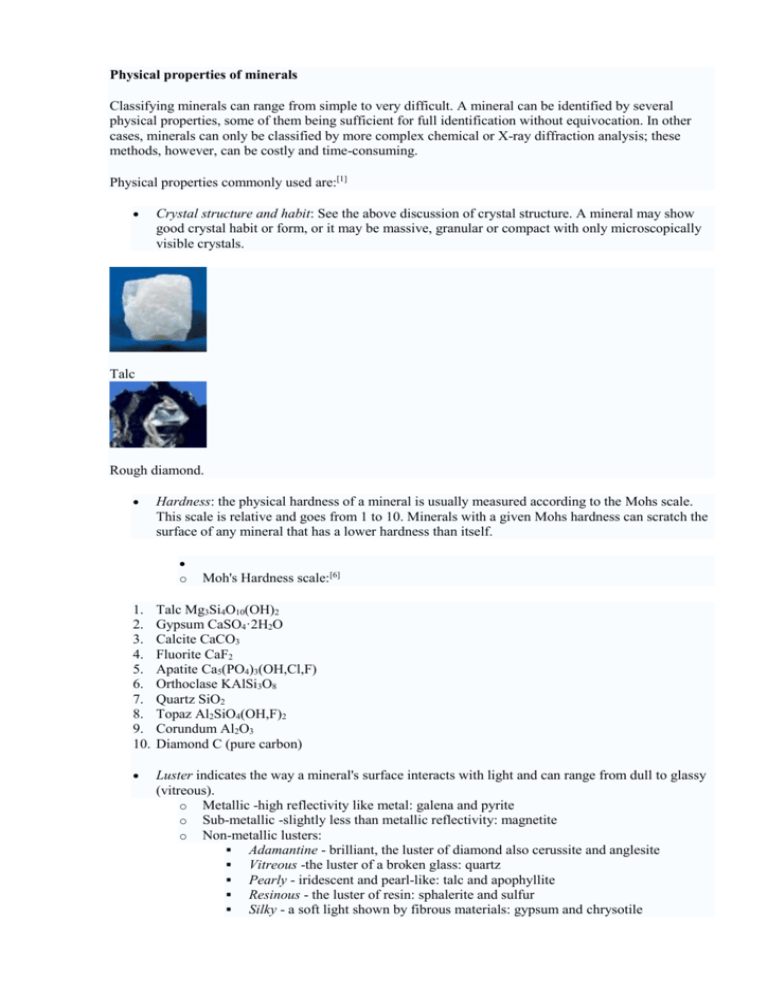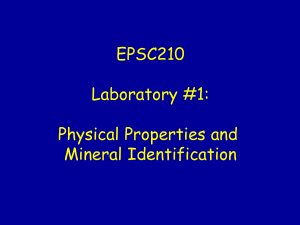Physical properties of minerals
advertisement

Physical properties of minerals Classifying minerals can range from simple to very difficult. A mineral can be identified by several physical properties, some of them being sufficient for full identification without equivocation. In other cases, minerals can only be classified by more complex chemical or X-ray diffraction analysis; these methods, however, can be costly and time-consuming. Physical properties commonly used are:[1] Crystal structure and habit: See the above discussion of crystal structure. A mineral may show good crystal habit or form, or it may be massive, granular or compact with only microscopically visible crystals. Talc Rough diamond. Hardness: the physical hardness of a mineral is usually measured according to the Mohs scale. This scale is relative and goes from 1 to 10. Minerals with a given Mohs hardness can scratch the surface of any mineral that has a lower hardness than itself. o Moh's Hardness scale:[6] 1. 2. 3. 4. 5. 6. 7. 8. 9. 10. Talc Mg3Si4O10(OH)2 Gypsum CaSO4·2H2O Calcite CaCO3 Fluorite CaF2 Apatite Ca5(PO4)3(OH,Cl,F) Orthoclase KAlSi3O8 Quartz SiO2 Topaz Al2SiO4(OH,F)2 Corundum Al2O3 Diamond C (pure carbon) Luster indicates the way a mineral's surface interacts with light and can range from dull to glassy (vitreous). o Metallic -high reflectivity like metal: galena and pyrite o Sub-metallic -slightly less than metallic reflectivity: magnetite o Non-metallic lusters: Adamantine - brilliant, the luster of diamond also cerussite and anglesite Vitreous -the luster of a broken glass: quartz Pearly - iridescent and pearl-like: talc and apophyllite Resinous - the luster of resin: sphalerite and sulfur Silky - a soft light shown by fibrous materials: gypsum and chrysotile Dull/earthy -shown by finely crystallized minerals: the kidney ore variety of hematite Color indicates the appearance of the mineral in reflected light or transmitted light for translucent minerals (i.e. what it looks like to the naked eye). o Iridescence - the play of colors due to surface or internal interference. Labradorite exhibits internal iridescence whereas hematite and sphalerite often show the surface effect. Streak refers to the color of the powder a mineral leaves after rubbing it on an unglazed porcelain streak plate. Note that this is not always the same color as the original mineral. Cleavage describes the way a mineral may split apart along various planes. In thin sections, cleavage is visible as thin parallel lines across a mineral. Fracture describes how a mineral breaks when broken contrary to its natural cleavage planes. o Chonchoidal fracture is a smooth curved fracture with concentric ridges of the type shown by glass. o Hackley is jagged fracture with sharp edges. o Fibrous o Irregular Specific gravity relates the mineral mass to the mass of an equal volume of water, namely the density of the material. While most minerals, including all the common rock-forming minerals, have a specific gravity of 2.5 - 3.5, a few are noticeably more or less dense, e.g. several sulfide minerals have high specific gravity compared to the common rock-forming minerals. Other properties: fluorescence (response to ultraviolet light), magnetism, radioactivity, tenacity (response to mechanical induced changes of shape or form), piezoelectricity and reactivity to dilute acids.






